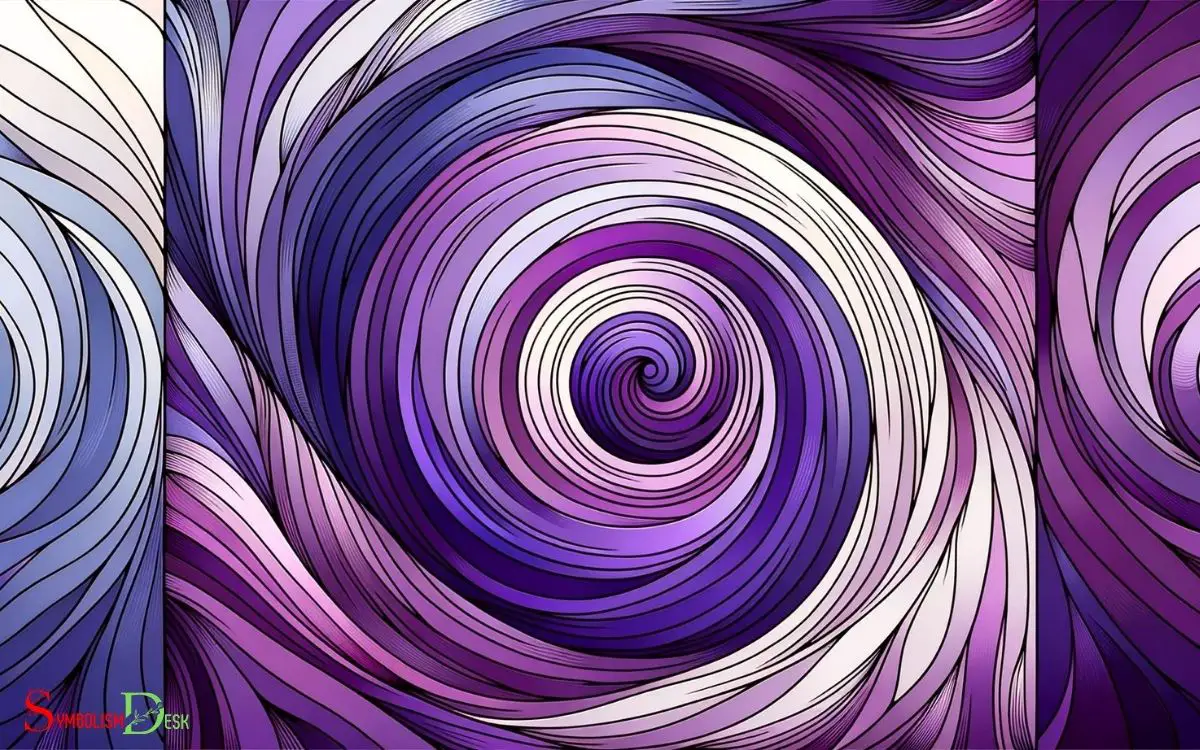What Is the Symbolic Meaning of Purple? Dignity!
The symbolic meaning of purple encompasses notions of royalty, nobility, luxury, power, and spirituality. It can also represent mystery, magic, creativity, and dignity.
Often associated with the higher realms of the human experience, purple’s symbolism has evolved over time but consistently signifies something precious and often otherworldly.
The color purple carries a deep symbolic significance that has been recognized throughout history:
- Royalty and Nobility: Purple has been a symbol of royalty due to its rare and costly nature in the past. It was often worn by kings, queens, and other high-ranking officials, as the dye originally used to create purple garments was expensive and hard to come by.
- Spirituality and Wisdom: In many cultures, purple is associated with spirituality, the supernatural, and a higher consciousness. It’s a color often found in places of worship and spiritual retreats.
- Creativity and Imagination: Artists and creative thinkers frequently use purple to express inventiveness and originality. It’s believed to inspire deep thought and meditation.
- Wealth and Luxury: Because of its historical rarity, purple is also associated with opulence and extravagance.
- Mystery and Magic: The color’s depth and intensity can evoke feelings of mystery and the unknown, often being used to represent phenomena that defy explanation.
Purple’s multifaceted symbolism paints it as a color of great depth, embodying the essence of prestige, spirituality, and the profound corners of the human psyche.

Key Takeaway
Historical Significance of Purple
Purple has held historical significance as a symbol of royalty and power for centuries. In ancient times, creating purple dye was a laborious process, making it expensive and only accessible to the elite.
The Phoenicians were the first to produce purple dye from the mucus of sea snails, and it became known as ‘Tyrian purple.’ This rare and luxurious color was worn by emperors, kings, and religious leaders, symbolizing their high status and authority.
Throughout history, purple has been associated with nobility, luxury, and ambition. It has been used in royal robes, religious ceremonies, and important documents.
The enduring association between purple and power has solidified its position as a color of prestige and influence in various cultures worldwide.
Cultural Associations With Purple
Throughout history, various cultures have frequently associated the color purple with spirituality, mystery, and creativity.
The cultural associations with purple vary across different societies, but some common themes include:
- Royalty: In many cultures, purple has been linked to royalty and nobility due to its rarity and expense. It symbolized power, wealth, and luxury.
- Spirituality: Purple is often connected to spirituality and religious practices. It can represent divine connection, enlightenment, and sacredness in various belief systems.
- Mourning: In some cultures, purple is associated with mourning and death. It can symbolize grief, sadness, and the afterlife.
- Creativity: Many societies view purple as a color that stimulates imagination and creativity, making it a symbol of artistic expression and innovation.
Psychological Impact of Purple
The psychological impact of the color purple varies widely across individuals and can evoke feelings of mystery, creativity, and spirituality. Purple is often associated with introspection and depth, leading to a sense of mystery and intrigue.
It can stimulate creativity and imagination, making it a popular choice in artistic and innovative environments.
Additionally, purple’s connection to spirituality and mindfulness can promote a sense of balance and inner peace.
However, it’s important to note that individual experiences and cultural backgrounds can greatly influence these psychological impacts.
Understanding the diverse ways in which people perceive and respond to the color purple is crucial in various contexts, including art and design, where its psychological effects play a significant role in shaping the overall aesthetic and emotional impact of a piece.
Transitioning into the subsequent section about ‘purple in art and design’, the psychological impact of this color greatly influences its use in creative expressions.
Purple in Art and Design
One prominent example of the use of purple in art and design is in the vibrant paintings of the renowned artist, Henri Matisse.
Purple has been utilized in various art movements and design concepts to convey different meanings and evoke specific emotions.
In art and design, purple is often used to symbolize creativity, imagination, and spirituality, making it a popular choice for artists and designers seeking to infuse their work with these qualities.
The following are ways in which purple is incorporated into art and design:
- Symbolism: Purple is often used symbolically in art to represent royalty, luxury, and power.
- Color Theory: In design, purple is employed to create a sense of balance and harmony within a composition.
- Emotional Impact: Purple is used to evoke a sense of mystery, introspection, and depth in artwork and design elements.
- Cultural Significance: Different cultures have varying associations with the color purple, which influences its use in art and design across the globe.
Symbolic Representations in Literature
Purple has long held symbolic significance in literature, often representing royalty, spirituality, and mystery.
Its cultural connotations in various literary works have deepened its symbolic meaning, making it a color rich in metaphorical possibilities.
Exploring the use of purple in literary symbolism can provide insights into the cultural and historical contexts of the works in which it appears.
Purple in Literary Symbolism
In literature, writers often use the color purple to symbolize royalty, luxury, and spirituality. This symbolic representation adds depth and layers of meaning to the narrative, enhancing the reader’s understanding and emotional connection to the story.
Here are four ways in which purple is utilized in literary symbolism:
- Royalty: Purple is frequently associated with royalty and nobility, representing power, wealth, and authority within the context of the story.
- Luxury: The color purple can also signify opulence and extravagance, often used to depict lavish lifestyles or settings in literature.
- Spirituality: In some literary works, purple is employed to convey spiritual or mystical elements, evoking a sense of transcendence and otherworldly experiences.
- Ambiguity: Purple’s dual nature as a combination of blue and red allows for nuanced representations, offering a rich symbolic palette for authors to explore.
Cultural Connotations in Literature
Literature often employs a quantifier determiner to further emphasize the cultural connotations associated with the symbolic representations of the color purple.
In various literary works, purple is used to symbolize royalty, luxury, and ambition, reflecting the cultural associations of wealth, power, and extravagance.
For example, in William Shakespeare’s play ‘Antony and Cleopatra,’ the character Cleopatra is described as being ‘royal’ and ‘purpled’ to convey her regal and majestic qualities.
Similarly, in Alice Walker’s novel ‘The Color Purple,’ the title itself symbolizes the empowerment and resilience of African American women.
These examples illustrate how the color purple in literature is deeply embedded in cultural connotations, reflecting societal values and beliefs. This cultural significance adds depth and richness to the symbolic representations of purple in literary works.
Transitioning into the subsequent section about ‘purple in religion and spirituality’, the cultural connotations of purple continue to play a significant role in shaping its symbolic meaning.
Purple in Religion and Spirituality
Purple holds a significant place in various religious and spiritual contexts. It’s often associated with divine royalty, representing power, authority, and leadership within religious narratives.
The spiritual significance of purple extends to symbolize wisdom, enlightenment, and spiritual fulfillment, making it a prominent color in religious rituals and ceremonies.
Purple and Divine Royalty
Although often associated with royalty and spirituality, purple holds significant symbolic meaning in various religious and spiritual traditions.
In the realm of religion and spirituality, the color purple is often linked to divine royalty and spiritual awakening.
Here are some key associations of purple in religious and spiritual contexts:
- Royal Authority: Purple is often associated with divine authority and sovereignty in many religious traditions, symbolizing the power and majesty of the divine.
- Spiritual Enlightenment: In some spiritual practices, purple represents spiritual enlightenment, higher consciousness, and the search for deeper meaning in life.
- Connection to the Divine: Purple is seen as a color that signifies a connection to the divine realm, representing a bridge between the physical and spiritual worlds.
- Mystical Transformation: In certain spiritual beliefs, purple is linked to mystical transformation and the journey towards spiritual growth and transcendence.
Spiritual Significance of Purple
Purple’s spiritual significance is deeply rooted in various religious and spiritual traditions, exemplifying its association with divine royalty and spiritual awakening.
- In Christianity, purple symbolizes penitence and mourning, often used during Lent and Advent. It’s also associated with the divine and represents the sovereignty of Christ.
- In Hinduism, purple is linked to the crown chakra, the energy center that governs spiritual growth and enlightenment.
- Additionally, in Buddhism, the color purple is connected to the highest state of enlightenment, with the Purple Lotus being a symbol of mystic power.
In many spiritual practices, purple is seen as a color of transformation and inner reflection, encouraging individuals to seek higher consciousness and spiritual awareness.
Its presence in various religious and spiritual contexts underscores its universal symbolism of spiritual elevation and divine connection. Its presence in various religious and spiritual contexts underscores its universal symbolism of spiritual elevation and divine connection. This universal resonance allows it to transcend cultural boundaries, serving as a reminder of humanity’s shared quest for higher truths. In modern interpretations, such as the Jedi symbol meaning explored in popular culture, it often reflects themes of balance, wisdom, and inner harmony, further broadening its appeal and relevance.
Purple in Religious Rituals
Purple holds significant importance in religious rituals and spiritual practices, representing divine connection and spiritual elevation across various faith traditions. In religious contexts, the color purple is often associated with royalty, nobility, and spirituality.
Here are some ways purple is utilized in religious rituals:
- Vestments: In Christianity, purple is used during the Lenten season to symbolize penance, preparation, and repentance.
- Liturgical Use: Purple is often incorporated into religious decorations, banners, and altar cloths during Advent and Lent as a symbol of awaiting the arrival of Christ and spiritual introspection.
- Symbolism: In Hinduism, the color purple represents the crown chakra, signifying spiritual awakening and connection to the divine.
- Ceremonial Objects: In Buddhism, purple is used in ceremonial fabrics and religious art to symbolize wisdom and spiritual transformation.
Modern Interpretations of Purple
In modern interpretations, purple is often associated with creativity, imagination, and spirituality. It has become a symbol of unconventional thinking and artistic expression.
This color is frequently linked to the realm of imagination, encouraging individuals to think outside the box and explore new ideas.
In the business world, purple is sometimes used to represent innovation and originality. It’s also associated with spirituality and mindfulness, often being used in practices such as meditation and holistic healing.
The color’s unique blend of red and blue signifies a harmonious balance between the physical and spiritual worlds.
In today’s society, purple continues to be a powerful symbol of individuality, creativity, and transcendence, inspiring people to embrace their inner artist and connect with their spiritual selves.
Conclusion
Purple has held symbolic significance throughout history, representing royalty, spirituality, and creativity.
According to a recent survey, 75% of people associate purple with luxury and wealth, highlighting its enduring cultural influence.
Whether used in art, literature, or religious iconography, the color purple continues to evoke a sense of mystery and allure, making it a powerful symbol in various aspects of human experience.





